To determine the half life of a radioactive element , a student plote a graph of in ∣∣∣dN(t)dt∣∣∣versust,Here∣∣∣dN(t)dt∣∣∣ is the rate of radioatuion decay at time t , if the number of radoactive nuclei of this element decreases by a factor of p after 4.16 year the value of p is
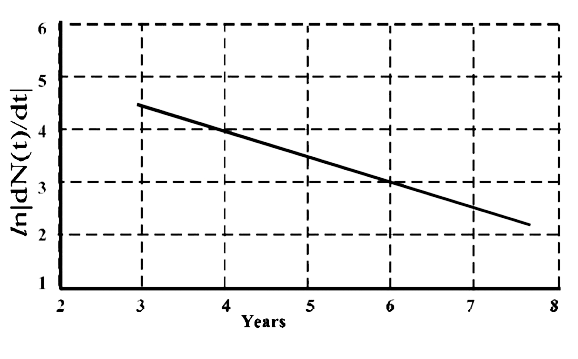 Solution in Gujrati
Solution in Gujrati
The correct Answer is:8
∣∣∣dNdt∣∣∣=λN0e−λt∴ln∣∣∣dNdt∣∣∣=ln(N0λ)−λt
∴ln∣∣∣dNdt∣∣∣=ln(N0λ)−λt⇒−λ= slope =−12year−1
⇒λ=12yr−1
∴t1/2=0.693λ=1.386 given time is 3 times of t1/2
∴ value of p is 8.
Topper's Solved these Questions
- SIMPLE HARMONIC MOTIONBOOK - ALLEN CHAPTER - SIMPLE HARMONIC MOTIONEXERCISE - Solved Example
3 Videos
- SIMPLE HARMONIC MOTIONBOOK - ALLEN CHAPTER - SIMPLE HARMONIC MOTIONEXERCISE - X Rays : Solved Example
2 Videos
- SIMPLE HARMONIC MOTIONBOOK - ALLEN CHAPTER - SIMPLE HARMONIC MOTIONEXERCISE - Paragraph
3 Videos
- RACEBOOK - ALLEN CHAPTER - RACEEXERCISE - Basic Maths (Wave Motion & Dopplers Effect) (Stationary waves & doppler effect, beats)
25 Videos
- TEST PAPERBOOK - ALLEN CHAPTER - TEST PAPEREXERCISE - PHYSICS
4 Videos
Similar Questions
A hydrogen like atom with atomic number Z is in an excited state of quantum number 2n. It can emit a maximum energy photon of 204 eV. If it makes a transition ot quantum state n, a photon of energy 40.8 eV is emitted. Find n, Z and the ground state energy (in eV) of this atom. Also calculate the minimum energy (in eV) that can be emitted by this atom during de-excitation. Ground state energy of hydrogen atom is – 13. 6 eV.
View SolutionWhen X-rays if wavelength 0.5Å pass through 10mm thick Al sheet than their intensity is reduced to one sixth . Find the absorption coefficient for Aluminium.
View SolutionA uniform thin cylindrical disk of mass M and radius R is attaached to two identical massless springs of spring constatn k which are fixed to the wall as shown in the figure. The springs are attached to the axle of the disk symmetrically on either side at a distance d from its centre. The axle is massless and both the springs and the axle are in horizontal plane. the unstretched length of each spring is L. The disk is initially at its equilibrium position with its centre of mass (CM) at a distance L from the wall. The disk rolls without slipping with velocity →V0=vacV0ˆi. The coefficinet of friction is μ.
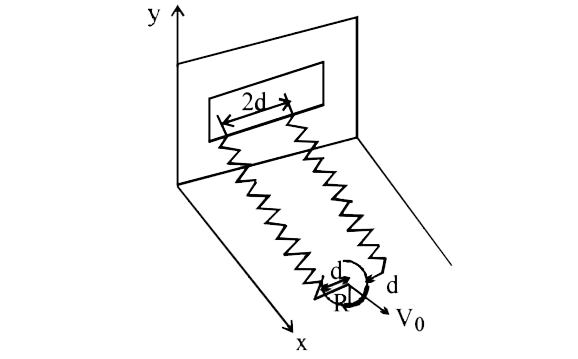
The net external force acting on the disk when its centre of mass is at displacement x with respect to its equilibrium position is.
View SolutionThe frequency of a radar is 780 MHz. After getting reflected from an approaching aeroplane, the apparent frequency is more than the actual frequency by 2.6 kHz. The aeroplane has a speed of
View SolutionChoose the correct statement:
View SolutionTo determine the half life of a radioactive element , a student plot a graph of in ∣∣∣dN(t)dt∣∣∣ versus t , Here ∣∣∣dN(t)dt∣∣∣ is the rate of radiation decay at time t , if the number of radioactive nuclei of this element decreases by a factor of p after 4.16year the value of p is

View SolutionNuclei of radioactive element A are produced at rate 't^(2') (where t is time) at any time t . The element A has decay constant lambda . Let N be the number of nuclei of element A at any time t . At time t=t_(0), dN//dt is minimum. The number of nuclei of element A at time t=t_(0) is
View SolutionIf −(dNdt)o is the initial activity and −(dNdt) is the activity at time t in a radioactive disintegration then :
View SolutionRadioactive element decays to form a stable nuclide, then the rate of decay of reactant ((dN)/(dt)) will vary with time (t) as shown in figure
View SolutionTo determine the half life of a radioactive element, a student plots a graph of In ∣∣∣dN(t)dt∣∣∣ versus t. Here dN(t)dt is the rate of radioactive decay at time t.
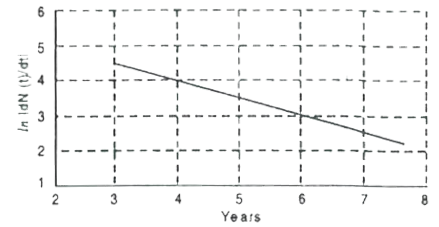
If the number of radioactive nuclei of this element decreases by a factor of p after 4.16 years. the value of p is...........
View Solutionकिसी रेडियोसक्रिय तत्व की अर्ध - आयु निकालने के लिए एक छात्र ln|dN(t)/dt| का एक t साथ ग्राफ़ बनता है [चित्र] यहाँ dN(t)/dt,t समय पर रेडियोसक्रिय क्षय की दर है। यदि इस तत्व के रेडियोसक्रिय नाभिकों की संख्या , 4.16 वर्षों के बाद p के घटक से कम हो जाती हो , तो p का मान है।
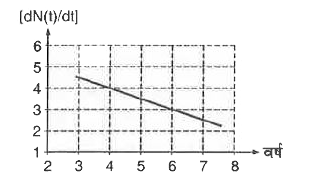
View SolutionDraw a graph showing the variation of decay rate (−dNdt) with number (N) of radioactive nuclei.
View SolutionA radioactive sample decays to form a stable nuclide. A graph showing variation of rate of disintegration (dNdt) of radioactive sample with time (t) is
View Solutionरेडियोधर्मी तत्व की अर्द्धआयु ज्ञात करने के लिये एक छात्र ln∣∣∣dN(t)dt∣∣∣ का t के साथ ग्राफ बनाता है। यहाँ dN(t)dt रेडियोधर्मी क्षय की। समय पर दर है। यदि 4.16 सालों के बाद इस रेडियोधर्मी पदार्थ के नाभिकों की संख्या p घटक से कम हो जाती है. p का मान बताइये।
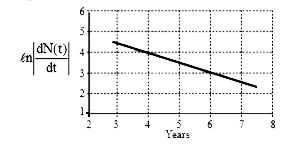
View SolutionNuclei of a radioactive element A are being produced at a constant rate α. The element has a decay constant λ. At time t=0, there are N0 nuclei of the element.
(a) Calculate the number N of nuclei of A at time t.
(b) If α=2N0λ, calculate the number of nuclei of A after one half-life of A, and also the limiting value of N as t→∞.
View Solution
